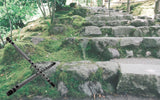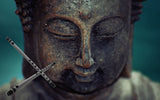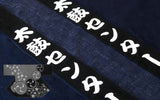Types of Shinobue Flute (Name and Origin: Where Did the Shinobue Come From?)
Shinobue is the traditional side-blown flute in Japan. It is often played in Japanese festivals. Also, played as the background music in the kabuki drama and played with vocal and shamisen in the nagauta music. In the taiko music, it makes the performance more attractive with the colorful sounds produced by the wide range of the key and the unique, natural, simple and emotional sounds. Unlike expensive Japanese flute like ryuteki played by noble people, simple shinobue has been played by ordinary people. Especially, the sounds of shinobue reminds us of the sounds of festival music.
|
|
1. Name
Japanese word, shinobue is consist of "shino" and "bue". Shino is named after the bamboo called shinodake, which is the material of the shinobue. Bue (fue) means the flute. So, you can just call it shino or fue.

2. Origin
It's said that the shinobue has been played widely in Heian period (794 - 1185). Compared to the ryuteki that played by noble people, it has been popular among ordinary people. Shinobue has very simple structure. It has thin vine of tou (rattan) around it and is painted with urushi (Japanese traditional lacquer) to prevent from the split.
It's said that the origin of the shinobue is ryuteki that was transmitted from China. But, the basic structure and scale are different between them and it's also said that the shinobue is just a simplified instrument of the ryuteki.

3. Type (Ohayashi & Uta)
There are two types of shinobue, "Ohayashi" and "Uta". In the modern taiko performance, "Uta" type is often played. The easiest way to tell "Uta" apart from "Ohayashi" is the fingering hole size. Because "Uta" is tuned properly, it has different size of fingering holes. On the other hand, "Ohayashi" keeps the traditional look and is not tuned to the western scale, the all fingering holes are same size.
Uta
Uta type is the modern shinobue that invented by Hyakunosuke Fukuhara between the beginning and the middle of the 20th century. Uta type is tuned and easier to play with the shamisen and the chants. To be tuned more accurate pitch, it is even played with the western music. This type is used in the modern taiko music, too.

View Shinobue Uta Type
Ohayashi
Ohayashi (or hayashi) is the noun form of the verb, hayasu, which means like to warm up and create the atmosphere by decorating the object with the music and chant. Although the role is close to the background music of the performance like dance and acrobatics, it has the meaning of sending off the holy sprits and decorating the object representative of the divine spirits when it comes to the Japanese festivals. Although the term of the hayashi is used in various ways, Japanese festival music is also called ohayashi and matsuri bayashi.
Shinobue has been played in such Japanese festivals. Ohayashi type is the original shinobue and often played in Japanese festivals and with lion dances. It is specially crafted for those purpose and the the interval of the fingering holes and the tuning are set up with the traditional theories.

4. Key (Choshi)
Key of the shinobue is called "Choshi" in Japanese. There are the lowest pitch "1 hon choshi" to the highest pitch "12 hon choshi". The lower the pitch of the shinobue is tuned in, the longer the length is. On the other hand, the higher the pitch is tuned in, the shorter the length is.

| Choshi: | 1 hon | 2 hon | 3 hon | 4 hon | 5 hon | 6 hon | 7 hon | 8 hon | 9 hon | 10 hon | 11 hon | 12 hon |
|---|---|---|---|---|---|---|---|---|---|---|---|---|
| Key: | F | G flat | G | A flat | A | B flat | B | C | D flat | D | E flat | E |
- Lowest Key: 1 hon choshi (F)
- Highest Key: 12 hon choshi (E)
- Popular Key: 6 hon (B flat), 7 hon (B), and 8 hon (C)
Listen and Understand Difference Between Choshi (8 hon, 7 hon, and 6 hon)
 |
Want to know how to play shinobue? See also this article. Fingering Chart of Shinobue |
5. Binding (Maki)
Binding is often wrapped around the shinobue to prevent from the split and make it look better.

Sudake:
Shinobue without any bindings.
Muji:
Same as Sudake (Ohayashi type like Shishida)
Sugatakan:
Same as Sudake (Rippei)
Shiratake:
Same as Sudake (Maruyama)
Tenchimaki:
Shinobue with bindings on the both ends. Harder than Sudake.
Ryomaki:
Same as Tenchimaki (Ohayashi type like Shishida)
Hanshige:
Shinobue with bindings on some parts
Soumaki:
Shinobue with bindings on many parts of shinobue
Honshige:
Same as Soumaki (Ohayashi type like Shishida)
6. Parts Name

Kanto (Head):
The end part of the shinobue is called kan-to. It writes number in Chinese characters and represents the key.
Utakuchi (Blow Hole):
The hole the player blows into.
Yubiana (Finger Hole):
Finger hole. There are 6 holes and 7 holes. Both 6 holes and 7 holes shinobue have the same scale. The reason is not clear but some people feel that the 7 holes shinobue sounds nice.
Maki (Binding):
Binding for shinobue is made of tou (rattan), kaba (birch), thread, and vinyl.
7. Painting (Nuri)
Natural looks are one of the biggest features of shinobue. But, there are many painted shinobue to make the look much better and prevent from the split.

Urushi:
Traditional Japanese lacquer. There are transparent urushi and colored urushi. It makes the shinobue harder and add natural texture. Also, the sound will become better as it is played.
Cashew Urushi:
Urushi-like artificial painting. It is more reasonable than urushi and hard to dry and humidity.
Artificial Painting:
It's hard to dry and humidity and cheaper than urushi.
8. Types of Bamboo
Shinobue is named after the name of bamboo, shinodake. Besides, there are other shinobue made of harder bamboo with and good texture.

Shinodake:
Shinobue is made from this types of bamboo.
Susudake (Smoke Bamboo):
It is often used for the roof material of the old Japanese house. It becomes amber susudake bamboo by roasting by fire place for decades and dry extremely. The natural brown taste is popular among many Japanese people.
Artificial Susudake:
Susudake bamboo made artificially. Hard bamboo is only used for it after placing bamboo in a strict environment to select hard bamboo.
Related Articles
 |
Want to know how to play shinobue? See also this article. Fingering Chart of Shinobue |
 |
Want to know embouchure? See also this article. Embouchure and Finger Placement of Shinobue |
😚Thank you for reading this to the end. Please feel free to ask any questions or leave any comments😉












































































